The Education and Public Programs Team at the Nixon Library is pleased to remind you that the National Archives and Records Administration (NARA) continues to be an excellent source for entertaining and historical content! Simply follow the links below for additional information.
![]()
50th Anniversary of the Apollo 15 Mission

Each space shuttle crew designs a patch that represents what it will do during the mission. The Apollo 15 patch features three stylized birds that would represent the all Air Force crew. A crater formation directly behind the birds spells "15" in Roman numerals (XV). The lunar surface shows the landing site next to Hadley Rille at the foot of the Apennine Mountains. “Mission Summary: Apollo 15,” NASA, last modified March 10, 2020, https://www.nasa.gov/mission_pages/apollo/missions/apollo15.html

Astronauts (left to right) David R. Scott, Alfred M. Worden, and James B. Irwin. “Apollo 15 Prime Crew Portrait,” Photograph, NASA/JSC, From NASA, July 28, 1971, https://moon.nasa.gov/resources/221/apollo-15-prime-crew-portrait/ (accessed July 14, 2021).
July 26, 2021 - August 7, 2021, celebrated the 50th Anniversary of Apollo 15, the eighth human space flight and fourth American manned space mission to land on the Moon. This mission accomplished a series of firsts that were both ambitious and exciting. The many scientific break-throughs and contributions of the Apollo 15 mission continue to be used today and influence NASA’s newest mission: The Artemis program.
![]()
A Series of Firsts
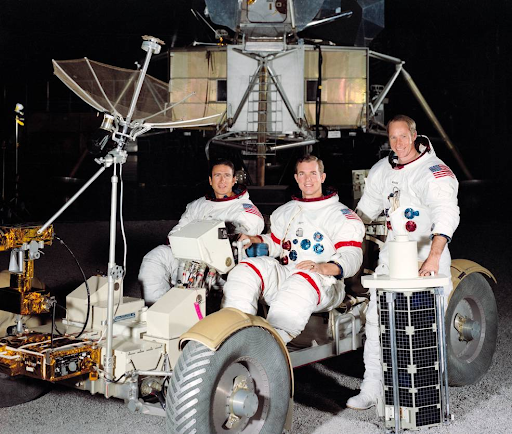
Apollo 15 astronauts James B. Irwin, left, David R. Scott, and Alfred M. Worden pose with mockups of a Lunar Module (LM), a Lunar Roving Vehicle (LRV), and a particle & fields subsatellite. “50 Years Ago: Three Months Until Apollo 15,” Photograph, NASA/JSC, From NASA, March 1971, https://www.nasa.gov/feature/50-years-ago-three-months-until-apollo-15 (accessed August 12, 2021)
Apollo 15, the first “J” mission, was capable of staying on the surface of the Moon for more extended periods. It was the first to use the lunar rover, extending the distance traveled across the surface in the Hadley-Apennine region of the Moon, and carried out more lunar orbital science activities than any previous mission. Where past missions focused on a safe lunar landing and return of astronauts from space, practice and advancements in technology allowed the Apollo 15 mission to focus on science. “Its primary scientific objectives were to observe the lunar surface, survey and sample material and surface features in a preselected area of the Hadley-Apennine region, setup and activate surface experiments, and conduct inflight experiments and photographic tasks from lunar orbit.” Astronauts Scott, Worden, and Irwin accomplished this by adding a scientific instrument module (SIM) and special geologic training received at “Coconino Point on Navajo tribal land near Flagstaff, Arizona – an area that included geologic features comparable to those at the Hadley-Apennine landing site on the Moon.” Of the many experiments conducted during the Apollo 15 mission, the most well-known is the test of Galileo’s hypothesis that all bodies fall towards the Earth with the same acceleration, tested with a geological hammer and a falcon feather, proving it correct. Astronauts Irwin and Scott also collected the Genesis rock, a sample of the Moon's crust, aged about four billion years old and 150 million years older than anything collected during previous missions.
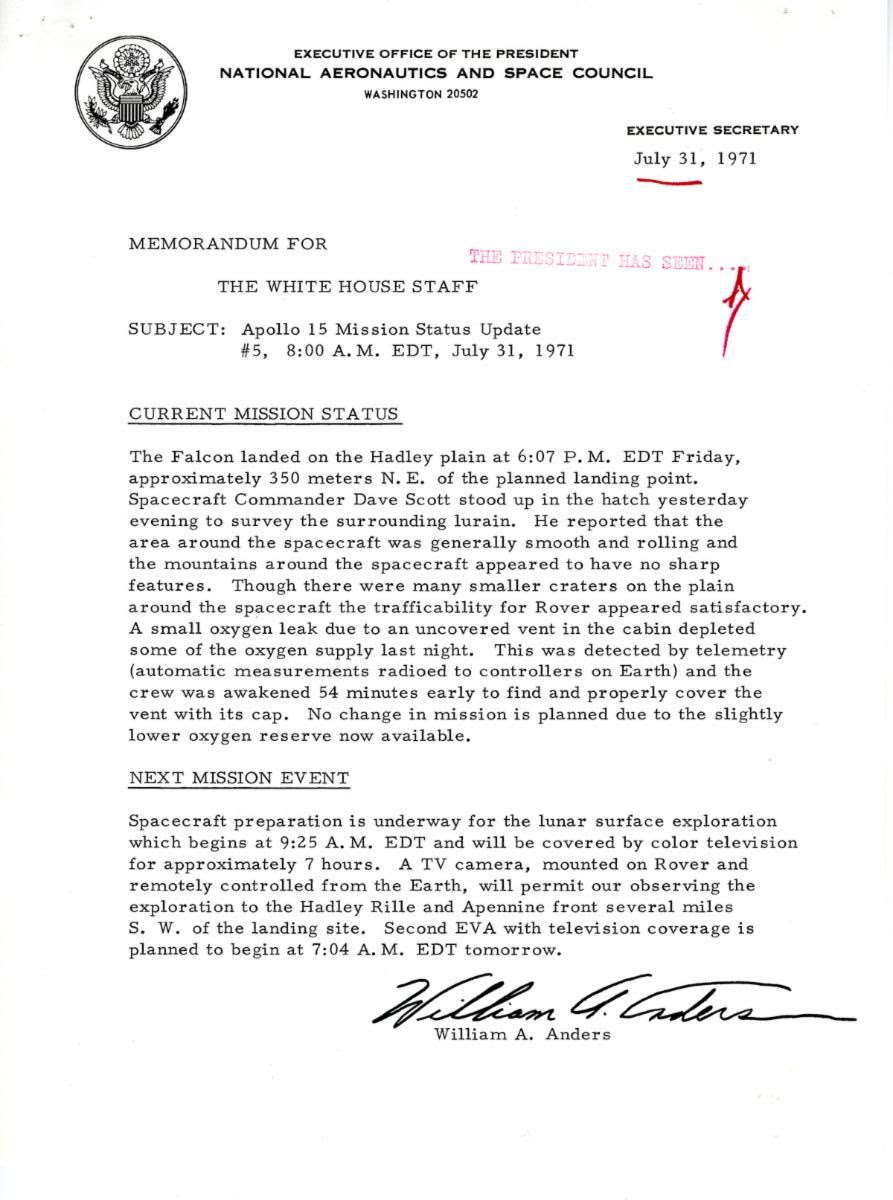
Apollo 15 Mission Status Update. White House Central Files, Subject Files, OS; box 8; [EX] OS 3 8/17/71-/31/71. Richard Nixon Presidential Library and Museum, National Archives and Records Administration.
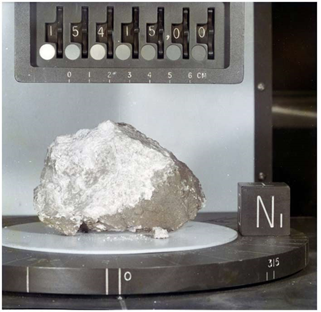
“Lunar-Missions- Apollo 15 Lunar Samples,” Lunar Planetary Institute (LPI), accessed July 13, 2021, https://www.lpi.usra.edu/lunar/missions/apollo/apollo_15/samples/
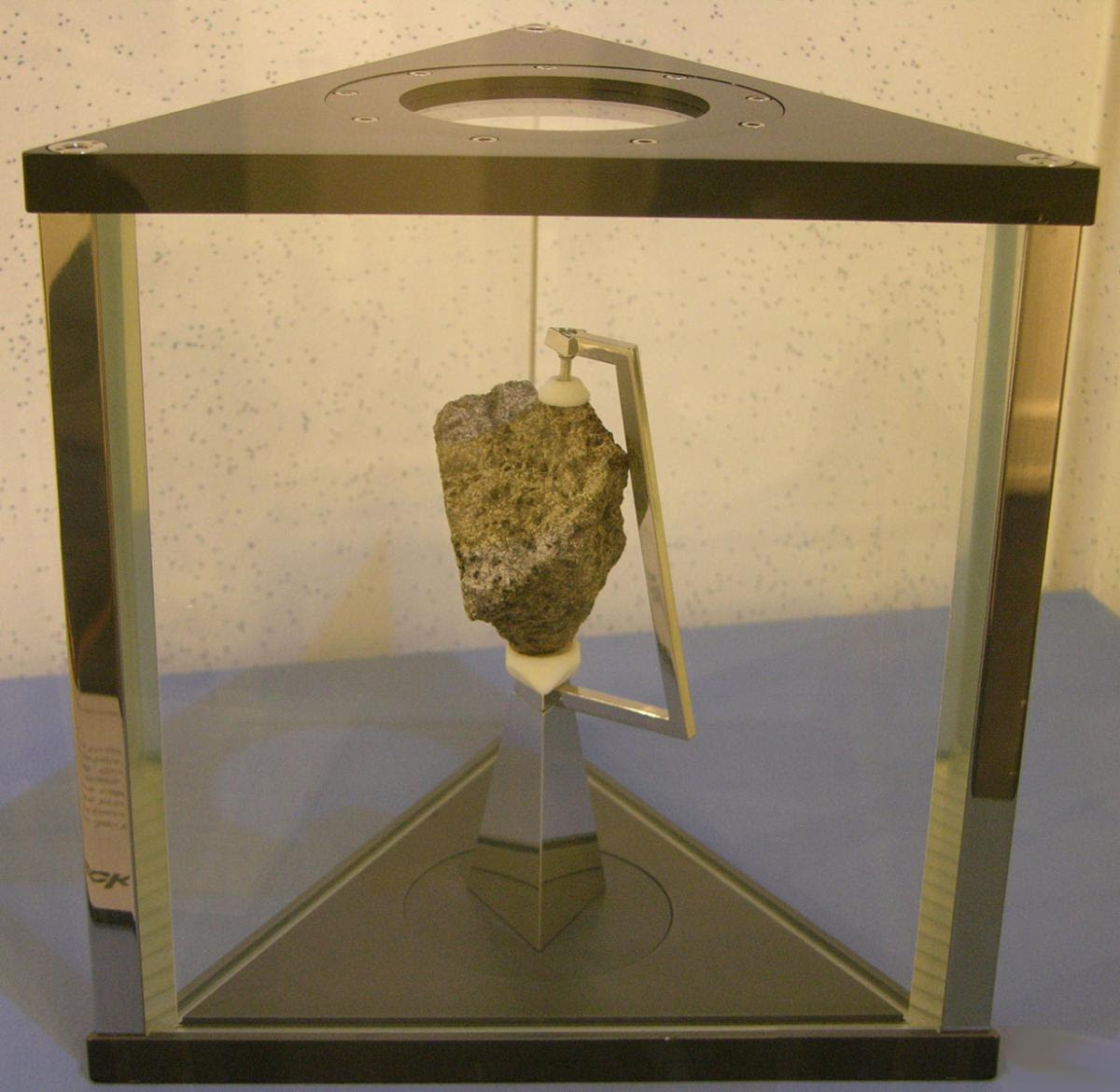
President Nixon received a moon rock from NASA on September 15, 1972. This is a portion of the largest rock called “Great Scott” brought back from the moon by the Apollo 15 astronauts. Astronaut Dave Scott collected it, thus named after him. Apollo 15 Lunar Sample No. 15555, weighs 165.57 grams, is about 3.3 billion years old and is encapsulated in a triangular- shaped display. On Loan Courtesy National Aeronautics & Space Administration, L.1990.3.1.
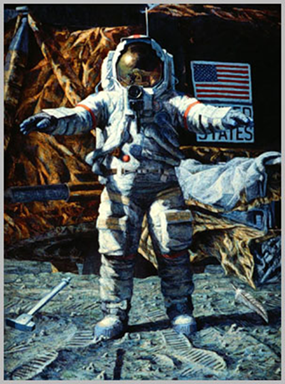
Bean, Alan, Artist and Astronaut. "The Hammer and the Feather,” Painting, Alan Bean Gallery. From the Alan Bean Gallery, 1986. http://alanbeangallery.com/hammerfeather-new.html (accessed July 14, 2021).
![]()
Homecoming
Shortly after Apollo 15 touched down in the Pacific Ocean, on August 7, 1971, President Nixon released this statement:
“APOLLO 15 has returned safely to earth.
It brings with it new proof of man's invincible will to master the moment of his own destiny. It brings new tribute to man's unquenchable thirst for understanding. It brings the seeds of scientific understanding, which may open a new chapter in the history of our planet.
We salute Astronauts Scott, Irwin, and Worden, who have stood poised on behalf of mankind on the brink of man's new world. To each we say well done, and welcome home.”
The Apollo 15 astronauts and their families were the guests of President and Mrs. Nixon on September 16, 1971. Following a dinner, held in their honor, the families spent time in the Yellow Oval Room. President Nixon was given a framed flag worn by James Irwin during extravehicular activity on the Moon.
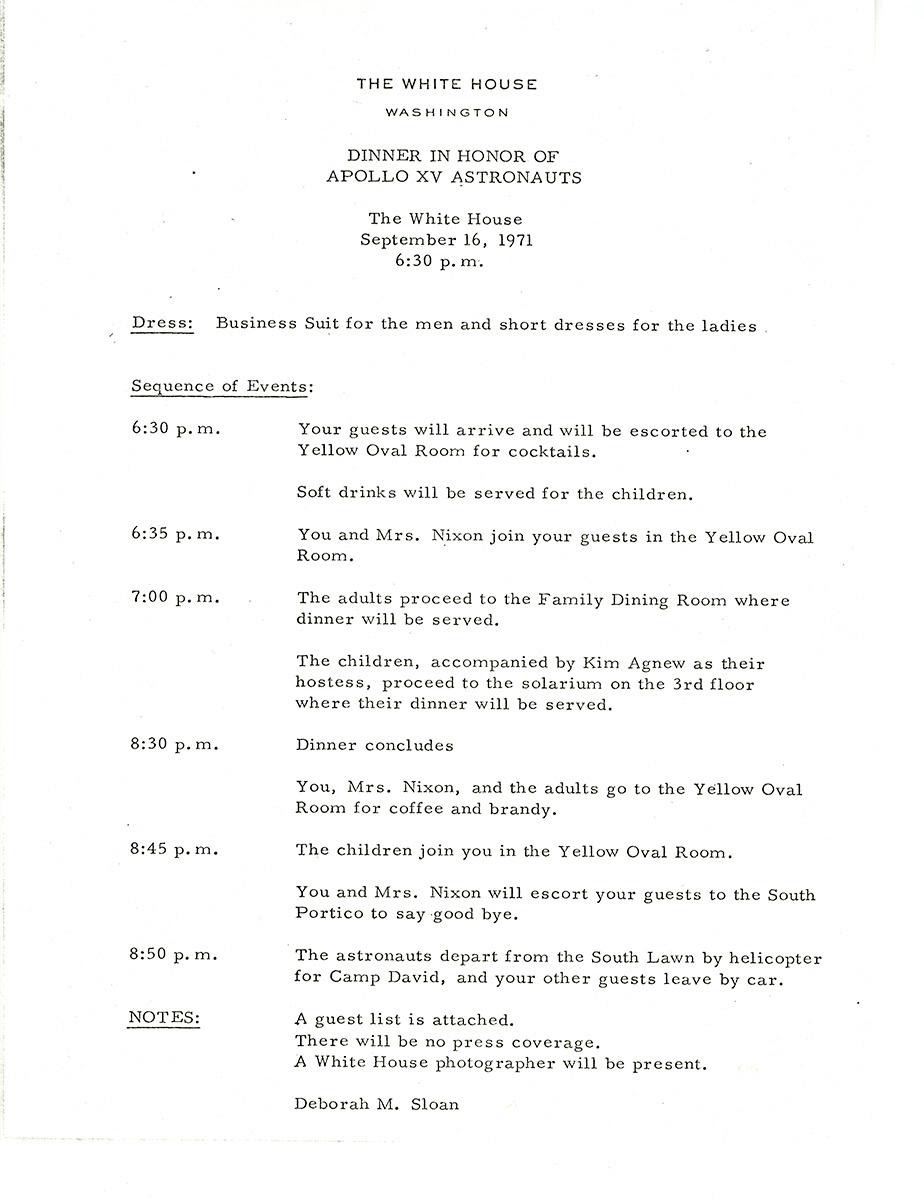
White House Itinerary for Dinner in Honor of Apollo XV Astronauts. White House Central Files, SMOF, Fox; box 37; September 16, 1971 Dinner (President and Mrs. Nixon) - Apollo 15 Astronauts. Richard Nixon Presidential Library and Museum, National Archives and Records Administration.
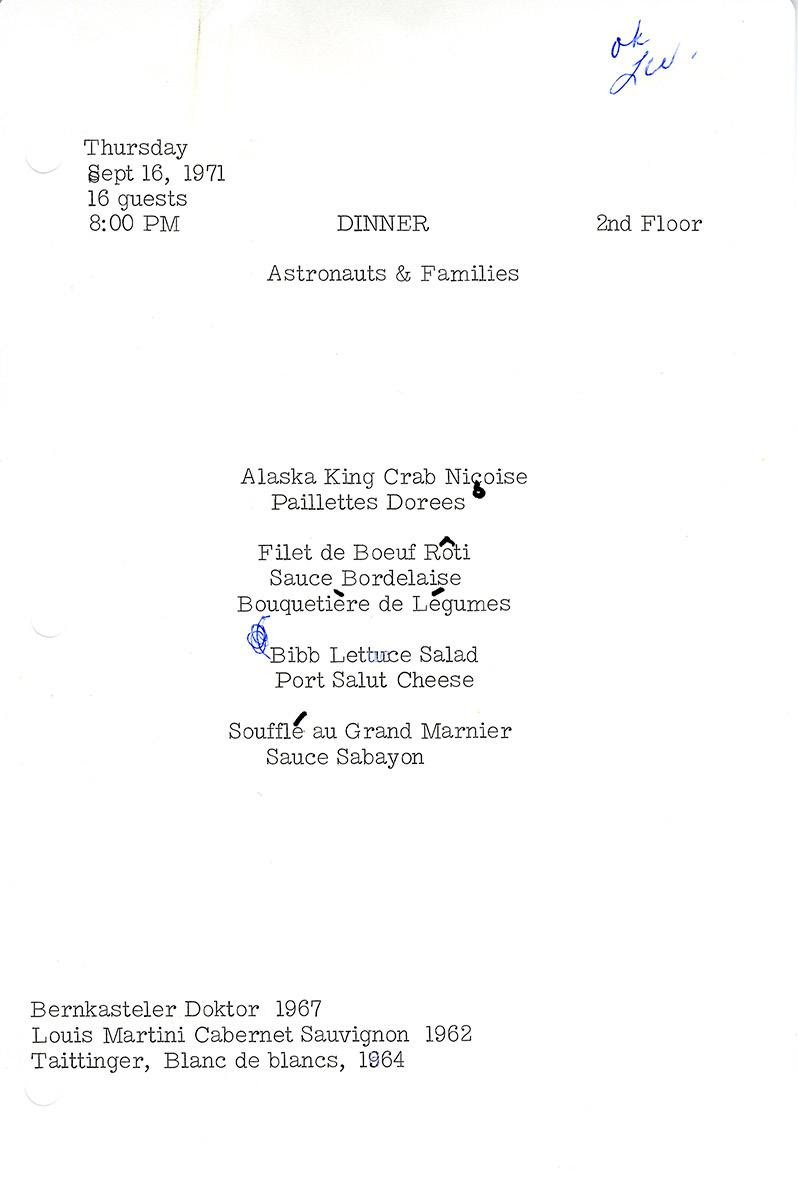
Dinner Menu for Honorary Apollo 15 Dinner. White House Central Files, SMOF, Fox; box 37; September 16, 1971 Dinner (President and Mrs. Nixon) - Apollo 15 Astronauts. Richard Nixon Presidential Library and Museum, National Archives and Records Administration.

The dinner guest list for the Apollo 15 celebratory evening at the White House. President Richard Nixon's Daily Diary, September 16, 1971.
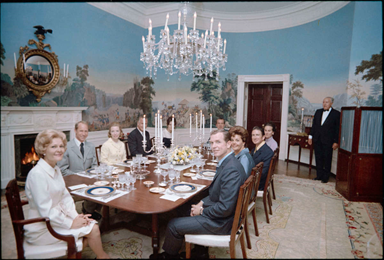
The Apollo 15 crew, along with their families, attend a dinner at the White House on September 16, 1971. (WHPO-7282-04A)
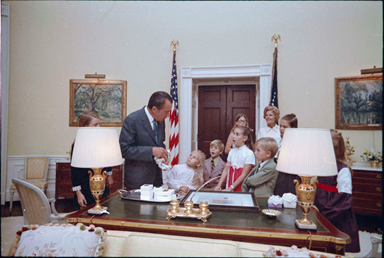
The President and First Lady entertained the younger guests on September 16, 1971. (WHPO-7282-12A)
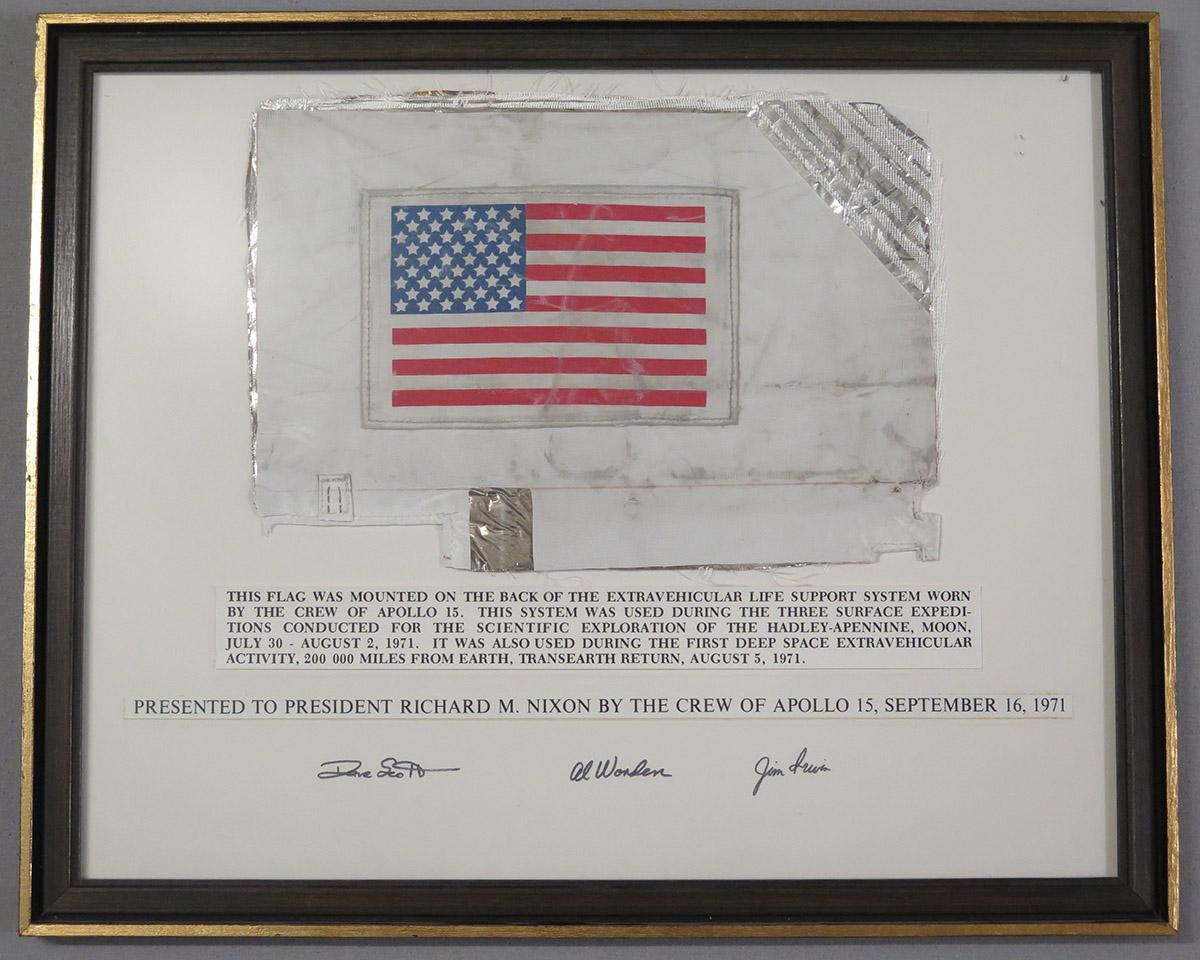
An American flag that was mounted on the back of the extravehicular life support system worn by the Apollo XV crew. It was mounted, signed by Apollo XV crew members, framed, and presented to President Nixon on September 16, 1971. Gift of Apollo 15 Astronauts to President Richard Nixon, D.1971.3517
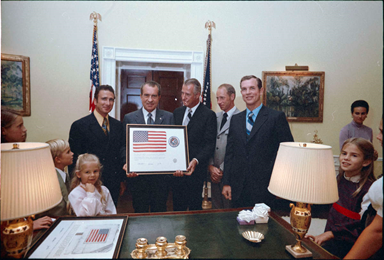
Photograph of the American flag being personally presented to President Nixon by the Apollo 15 crew on September 16, 1971. (WHPO-7282-19A)
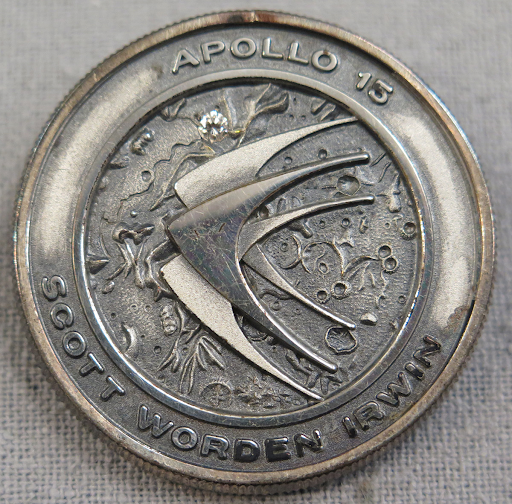
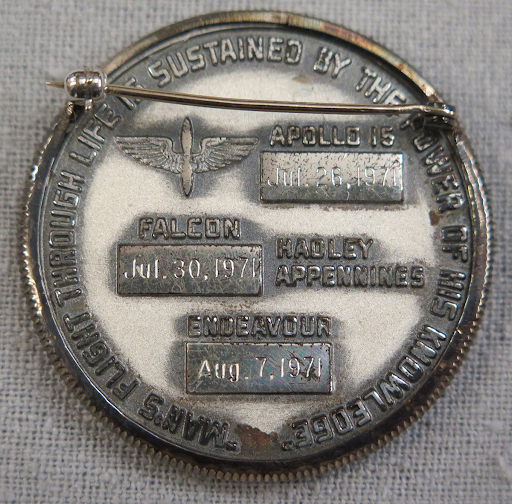
Apollo XV Commemorative Lapel Pin, the Apollo XV emblem set in silver with a diamond chip. The reverse includes the astronauts' names and NASA motto. Gift of Apollo 15 Astronauts, Col. David R. Scott, Major Alfred M. Worden, Lt. Col. James B. Irwin, to First Lady Pat Nixon, D.1972.2255

Thank you note to the Apollo 15 astronauts from President Nixon. White House Central Files, SMOF, Fox; box 37, 9/24/71. Richard Nixon Presidential Library and Museum, National Archives and Records Administration.
![]()
Controversy

A postal cover canceled on the Moon by astronaut Dave Scott on August 2, 1971, during the Apollo 15 mission. It carries two advanced, hand-perforated die proofs of stamps celebrating the U.S. space program. “Apollo 15 Lunar Mail Cover,” Photograph, National Postal Museum. From United States Postal Service, Post Master General’s Collection, 1971. https://postalmuseum.si.edu/object/npm_PMG.4.4 (accessed July 14, 2021).
The United States Postal Service (USPS) collaborated with NASA to raise public awareness and enthusiasm for the space program. Beginning in 1960, the USPS started issuing commemorative stamps to celebrate American achievement in space. Mission-themed postal covers and stamps were the most prized of stamp collectors worldwide, and NASA delegated a certain number into space with every mission. It was custom for Astronauts to take personal artifacts “onboard their spacecraft for themselves, their families or to distribute to others after their safe return." A controversy involving 400 postal covers shuttled to the Moon's surface by the crew for profit overshadowed their accomplishments. The covers, sold soon after the lunar landing, quickly became public knowledge and NASA reprimanded the three astronauts. Similar incidents were recorded during previous space flights including silver medallions from the Franklin Mint and a corned beef sandwich. In October 2011, James Worden addressed the scandal, stating, “I think NASA management felt they had to do something. There had been a similar incident the previous year, when the Apollo 14 crew allegedly made a deal with the Franklin Mint to bring silver medallions into space. But NASA kind of smoothed that over because the [astronaut] involved was Alan Shepard, (the first American in space] who was a little more famous than we were. The government never said that we did anything illegal, they just thought it wasn’t in good taste.”
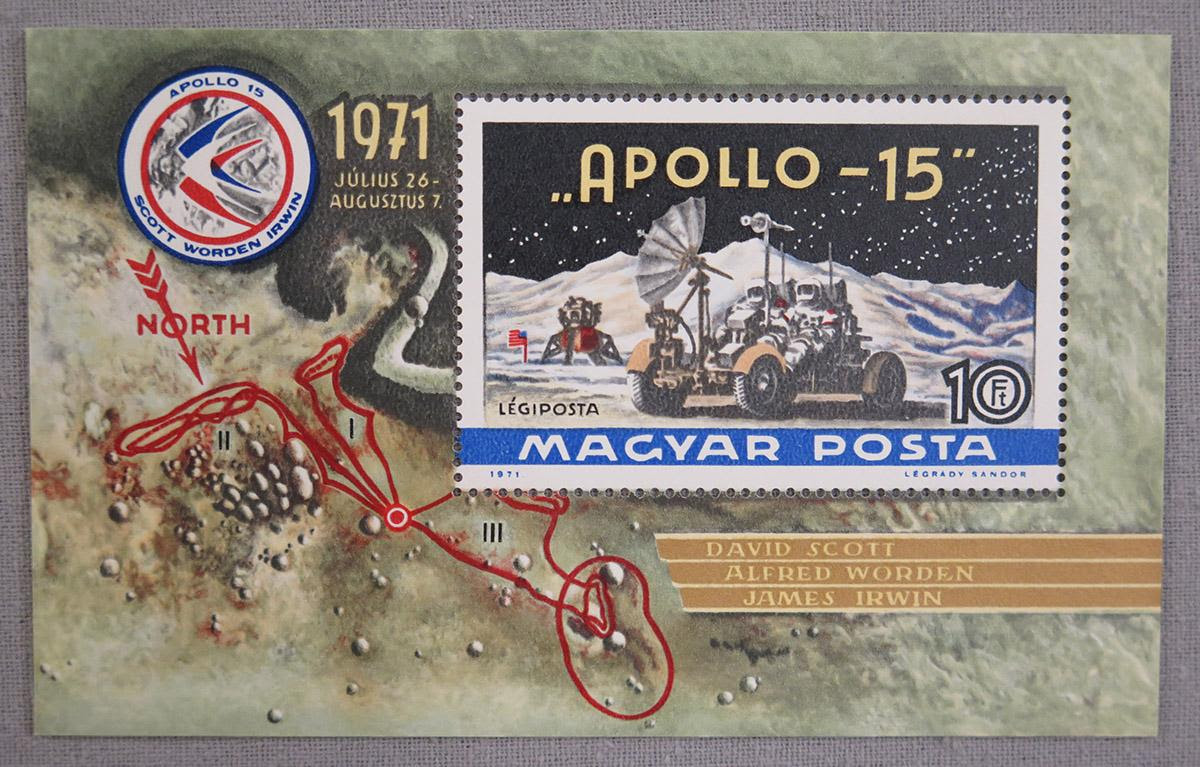
Commemorative 1971 Apollo 15 stamp. Gift of Ambassador Karoly Szabo to President Richard Nixon, HS.1972.95.a.
![]()
Legacy
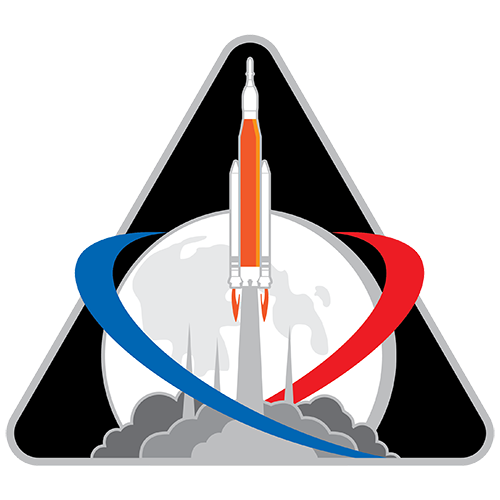
Official emblem of Artemis 1 “NASA Artemis” NASA, https://www.nasa.gov/specials/artemis/
On July 26, 2021, the 50th Anniversary of the Apollo 15 launch, NASA released a video celebrating the mission's triumphs. Apollo 15 was an ambitious mission that completed all of its objectives, setting the groundwork for the two final Apollo missions before lunar landings ceased in 1972. The Apollo 15 mission “demonstrated the importance of geological field training,” empowering the crew to recognize the importance of the Genesis rock while on the Moon and enhanced performance on the lunar surface. Its legacy continues to resonate into the future with training of the current Artemis class.


